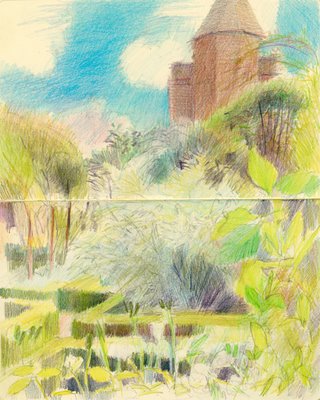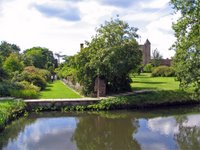 The Front Line
The Front Line(Houndsditch, City of London 17.09.07. 12.30pm)
11" x 16", pen and ink and coloured pencil in sketchbook
copyright Katherine Tyrrell - all rights reserved (see note at end)
I've just spent three days trying to get my money out of
Northern Rock - and took my sketchbook with me to the very long wait outside two different branches of Northern Rock on both Saturday (Bromley) and Monday (Houndsditch in the City of London). This post has drawings from the front line of the 'run' on a bank and some comment from me for the context of each one - from the perspective of the queue. Note I also now have a new category on this blog called 'life events'!
We are in the middle of a bank run. We've never seen it on this scale in Britain - of a major bank - since the 19th century.
Will Hutton, The Work Foundation and former Editor of The Observer quoted on this BBC site
(See links at the bottom of this post and
today's post on "
Making a Mark" for the context of what has happened at Northern Rock. Bottom line - NR is the 5th largest bank in the UK and we've just been through a massive crisis in confidence for people depositing money in the banking system - and a 'run' on a bank.)
The first sketch (below) was done on Saturday - after I heard about the problem with Northern Rock late on Friday night. I went to bed very worried as I had a sizable chunk of my life savings in Northern Rock and woke at 4.00am, got on the Internet and eventually decided that I had to go and get my money out. I went down to the closest branch which was open on Saturday morning - in
Bromley in south east London. I got there at 9.00am and the queue already had several hundred people in it. It then took me 5 hours to move about 100 feet forward in the queue. BUT nobody who arrived after 8.00am got inside the branch on Saturday.
On Friday, branch customers withdrew £1 billion pounds and we later learned another £1 billion was withdrawn in 5 hours on Saturday.
 The queue that got nowhere (Northern Rock, Bromley 15.09.07 1.00pm)
The queue that got nowhere (Northern Rock, Bromley 15.09.07 1.00pm)
11" x 16", pen and ink and coloured pencil in sketchbook
copyright Katherine Tyrrell - all rights reserved (see note at end)I'd estimate about 90% of the queue at Bromley were pensioners - including some very elderly people and three people in wheelchairs. I'd estimate the average age of the queue to be about 70-75 years old - but some were much older. Anxieties forced us all to queue outside the branch for up to five hours. Virtually everybody in the queue at Bromley had - as I did - their pension lump sums or life time savings in Northern Rock. Naturally for a lot of people this was an awful lot of money and most had well in excess of the £35,000 compensation limit and most were planning to withdraw the lot. It was a very tense time.
(Top) The sketch at the top is
the scene outside the Northern Rock branch at 155 Houndsditch on Monday 17th September. I did this one from across the road in Starbucks at 12.30pm after I'd got my withdrawal lodged somewhere safe and before going home.
Having queued for five hours on Saturday (and then spent all Saturday evening and Sunday 'seized up' and virtually immobile as a result) I decided I had to get to the branch nearest my home on Monday as early as possible.

So I got up at 3.50am, got a taxi into the City of London and arrived at Houndsditch about 4.30am to find I was first in the queue! I then sat outside the branch for three and three quarter hours until the branch opened (I can highly recommend my new chair for comfort while sketching!).
At 5.00am 'H' arrived. He was an 80 year old pensioner who had managed to get the last stand-by seat to fly back from abroad to get his money out. He'd got a lift in from a taxi driver. At 6.30am we had our photo taken by a man on his way to work in the city who could not believe what he was seeing and then we both gave interviews to the independent radio news reporter! Other people started to arrive at 6.00am and then there was a steady trickle joining the queue as the early morning tubes and trains started to arrive in the City of London.
Drawing from the Northern Rock
11" x 8.5", pen and sepia ink and coloured pencil in sketchbook
copyright Katherine Tyrrell - all rights reserved (see note at end)
The next sketch (right) was done while I was sat inside the branch. The printer failed, the computer could not read my pass book and the manager had to update my book for interest by hand! I did this sketch while she was doing that. I'd chatted to this couple, both pensioners, in the queue for the previous two hours as we waited for the branch to open.
I exchanged some pleasantries with the Branch Manager and we talked about how things used to be. Northern Rock used to be a Building Society until about 10 years ago. As with all building socities - before they converted to banks - in order to get a mortgage, you had to save with the building society first and then wait for an allocation from the 'quota' of funds which were released each month. It used to be that if depositer's funds dried up so did mortgages. I think it's a very great pity that it has changed and brought so much stress to so very many people, particularly pensioners. After this fiasco, I think we'll see a resurgence of "mutuals" limited to lending savers money for
homes.
It took about half an hour to update my savings passbook with all the interest and I walked out with a cheque for the amount which was the excess above the sum covered by the Government Compensation Scheme in the event of a failure of Northern Rock. It then took about two and half hours to get the cheque placed in a 100% Government backed National Savings and Investment account!
Late in the afternoon, as the Chancellor and others began to realise that it was apparent that nobody believed what the CEO, the Bank of England, the FSA or the government had said so far,the Chancellor finally stated that
all depositers money in Northern Rock would be guaranteed 100%. Which may have meant I wasted my time yesterday but did at least mean that I could get a good night's sleep last night and don't plan to get up early tomorrow morning to take the rest of my money out. It's now safe.
The simple fact now is that the Chancellor has made it clear that all existing deposits in Northern Rock are fully backed by The Bank of England and are totally secure during the current instability in the financial markets.
We are all working night and day to provide you with the service that you expect from us and deserve from us. And I would like to express my appreciation to our staff for their work and commitment over the last few difficult days.
Above all I would also like to thank all our customers for their support and understanding.
I am also pleased to announce that any customer who has paid a penalty for withdrawing their investment, will have the penalty refunded if they re-invest the same amount in the same type of account by 5th October 2007.
Extract of letter from the Chief Executive of Nothern Rock on front page of the Northern Rock website
Note: Please note all rights are reserved in respect of all images and text on this blog. Please contact me if you want to copy either sketches or my comments.
Links:
 Fish! Supper
Fish! Supper












